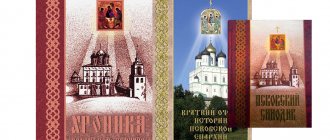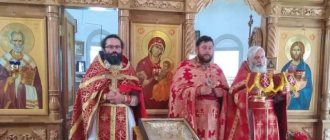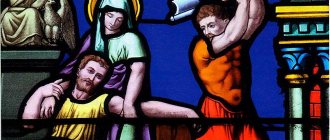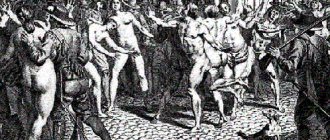| Tashkent Assumption Cathedral |
Tashkent and Uzbekistan Diocese
of the Central Asian Metropolitan District of the Russian Orthodox Church
- Diocesan administration: Uzbekistan, 700047, Tashkent, st. Sadyk Azimov, 3rd dead end, 22
- Tel.: (99-871) 233-33-21 (office); fax: (99-872) 236-79-39
- Official site:
- Canonical territory: Uzbekistan
- Cathedral: Assumption in Tashkent
- On the map: Yandex.Map, Google map
The highest decree confirming the Synodal decision on the establishment of an independent Tashkent and Turkestan diocese followed on May 4, 1871 [1].
However, due to the opposition of secular officials who feared restrictions on their autocracy, the city of Verny (now Alma-Ata) became the center of the diocese, although the name remained the same. Only by the decision of December 16, 1916, the center of the Turkestan diocese, which covered all the Central Asian possessions of Russia, actually moved to Tashkent, and the Vernensky department became the Semirechensky and Vernensky vicariate. From 1923 to 1944 there was a renovationist diocese of the same name.
In 1937-1944, the Orthodox department was abolished, after which it was resumed on the territory of all Central Asian republics of the USSR.
On October 12, 2007, a patriarchal deanery was created on the territory of Turkmenistan, separated from the Tashkent diocese.
On July 27, 2011, the Bishkek See on the territory of Kyrgyzstan and the Dushanbe See on the territory of Tajikistan were separated from the diocese, with which Uzbekistan remained under the jurisdiction of the Tashkent See. At the same time, the Central Asian Metropolitan District was formed in which the Tashkent diocese became metropolitan.
Historical names
- Turkestan and Tashkent
- Tashkent and Turkestan
- Tashkent and Central Asian (1944 - July 27, 2011)
- Tashkent and Uzbekistan (since July 27, 2011)
Statistics
- January 1, 1958 - 68 registered temples/houses of worship [2]
- 2006 - 105 parishes; 133 clergy (115 priests, 18 deacons); 38 Sunday schools [3]
- May 2015 – 38 churches are operating [4]
Bishops
with a pulpit in Verny
(1871 - 1916) - see Vernensky diocese
with a department in Tashkent
- Innokenty (Pustynsky) (December 16, 1916 - March 1923)
- St. Luka (Voino-Yasenetsky) (May 12, 1923 [5] - 1923, January 25, 1925 - September 1927)
- Sergius (Lavrov) (1923 - September 1927) high school, ep. Alma-Ata, then, from January 25, 1925 - Semirechensky [6]
- Nikandr (Phenomenov) (1927 - March 3, 1933)
- Afanasy (Malinin) (March 23 - August 24, 1933, did not go to the diocese)
- Arseny (Stadnitsky) (August 24, 1933 - February 10, 1936)
- Boris (Shipulin) (March 13, 1936 - 1937)
- 1937-1944 - stopped
- Platon (Lobankov) (February 28 - June 25, 1971) v/u, ep. Samarkand
Russian Orthodox Church
Part of the Central Asian Metropolitan District
On May 4, 1871, the Turkestan diocese was established. Initially, the center of the diocese was in the city of Verny (Alma-Ata), and in 1917 the department of the ruling bishop was moved to Tashkent. During the years of persecution of the Church, many churches were destroyed or closed. From 1937 to 1945, the diocese existed without episcopal leadership; in all of Central Asia there remained only one functioning Orthodox church - the Intercession Cathedral in Samarkand, the rest of the parishes were either closed or headed by “renovationist” heretics. Despite the persecution, a gradual revival of the Church began in the late 1940s. However, only after 1991 were all the necessary conditions created in the Central Asian republics for the normal implementation of the spiritual life of Orthodox believers.
By the decision of the Holy Synod of October 12, 2007 (journal No. 106), the Patriarchal Deanery of the parishes of the Russian Orthodox Church in Turkmenistan was separated from the Tashkent diocese.
By the decision of the Holy Synod of July 27, 2011 (magazine No. 67), the Bishkek and Dushanbe dioceses were separated from the Tashkent diocese. The Synod of Tashkent decided to have the title “Tashkent and Uzbekistan”.
The Synod also decided that His Eminence of Tashkent and Uzbekistan be the head of the Central Asian Metropolitan District. In matters concerning the Central Asian Metropolitan District, as well as during liturgical commemoration in dioceses other than those headed by himself, the Synod decided to title the head of the Central Asian Metropolitan District “Metropolitan of Central Asia.”
The Holy Synod, at a meeting on October 6, 2021 (journal No. 81), approved the charter of the Tashkent-Uzbekistan diocese.
***
Unites parishes and monasteries on the territory of Uzbekistan.
Cathedral city - Tashkent. Cathedral: Assumption (Tashkent).
Deanery districts: Bukhara, Gulistan, Samarkand, Tashkent, Fergana.
Diocesan departments: educational; artistic and production; for youth affairs.
Active monasteries:
- Dustabad in honor of the Intercession of the Holy. Mother of God women monastery, founded in 1992 as a courtyard of the Tashkent Trinity-St. Nicholas Monastery, in 1998 transformed into an independent one. Uzbekistan, 702739, Tashkent region, Dustabad, st. Mukhamedkulova, 85. Tel.: (998-71) 7-37-30, 7-26-11;
- Tashkent in the name of the Holy Trinity and St. Nicholas the Wonderworker (wives) mon-ry, established in 1894 as a community, in 1901 received the status of mon-ry, closed in 1922, reopened in 1990. Uzbekistan, 700005, Tashkent, st. March 8, 7. Tel.: (10-998-71) 191-69-60, 191-49-89;
- Chirchik in the name of the Great Martyr. George's husband monastery, established in 1996. Uzbekistan, 702100, Tashkent region, Chirchik, ave. A. Navoi, 1a. Tel.: (998-71) 5-50-33.
Educational establishments:
- Tashkent Theological Seminary, opened in 1990 as a school, in 1998 reorganized into a seminary. Uzbekistan, 700015, Tashkent, st. Avliyota, 91. Tel.: (998-71) 55-54-15.
Church media: the newspaper “Word of Life”, published by the diocesan administration, has an appendix - the almanac “East from Above”.
Geography of deaneries
- Tashkent:
- Tashkent, Almalyk, Angren, Akhangaran, Bekabad, Gazalkent, Dustabad, Krasnogorsk, Chinaz, Chirchik, Yangiyul
- Bukhara, Kagan, Zarafshan, Navoi, Nukus, Urgench, Uchkuduk
- Gulistan city, Jizzakh city, Syrdarya city, Khavast city
- Samarkand, Denau, Karshi, Kattakurgan, Termez
- Fergana, Andijan, Kokand, Kuvasay, Namangan
History[ | ]
In June 1865, Tashkent was captured by a detachment of General Mikhail Chernyaev.
In 1868, the Turkestan Governor-General Konstantin Petrovich von Kaufman filed a petition for the establishment of a special diocese in the regions of the Turkestan General Government (due to the remoteness of the Orenburg and Tomsk diocesan administrations, which included the churches and clergy of the region entrusted to him); however, categorically not wanting the diocesan bishop to be in Tashkent, he asked to appoint the latter’s seat in the regional city of the Semirechensk region - the city of Verny. Kaufman’s petition was “respected according to the Supremely approved opinion of the State Council on May 1, 1871”[1].
On November 12, 1871, Bishop Zephaniah (Sokolsky) (formerly Bishop of Novomirgorod, vicar of the Kherson diocese; † November 26, 1877) was appointed to the newly established Turkestan see with the title “Tashkent and Turkestan”.
Since 1896, the diocesan authorities initiated petitions for the transfer (or formation of a separate) department in Tashkent[2].
In 1900, the Trans-Caspian region was transferred to the diocese from the Georgian diocese.
Due to the vastness of the territory of Turkestan and the small number of parish churches, the majority of the Orthodox population was assigned to the military “fixed” churches, which in 1900 passed from the diocesan administration to the department of the protopresbyter of the military and naval clergy; in 1911, Bishop Dimitri (Abashidze) petitioned the Holy Synod for their return to the diocesan administration, which was partially satisfied[3].
On December 16, 1916, the report of the Holy Synod on the transfer of the department of the Most Reverend Verninsky from Verny to Tashkent was approved by the Highest (a vicariate was established in Verny)[4].
In the spring of 1923, in the Turkestan diocese, most of the clergy and parishes recognized the authority of the Renovation Synod (the diocese came under the control of the Renovation Bishop Nikolai (Koblov)); Archbishop Innocent (Pustynsky), who ruled the diocese, left the diocese without permission after the arrest of a number of “Old Church” clergy.
In the period 1927-1929, the Tashkent diocese (“old church”) was ruled by Bishop Luka (Voino-Yasenetsky), who returned from Siberian exile. Until 1933, the diocese was headed by Metropolitan Nikandr (Fenomenov), then Metropolitan Arseny (Stadnitsky), who was here in exile; the only temple under their jurisdiction was the “Joy of All Who Sorrow” church in the cemetery.
After the death of Metropolitan Arseny in 1936, the diocese was divided into “Tashkent and Central Asian” and “Alma-Ata and Kazakhstan”. After the arrest and execution of Archbishop Tikhon (Sharapov) in 1937, both dioceses remained widowed until 1945.
In 1943, the only Orthodox church was reopened - the Assumption Hospital, which later became the cathedral.
Under Bishop Guria (Egorov) (1946-1953), the number of parishes in the diocese reached 66. Bishop Ermogen (Golubev) (1953-1960) managed to prevent the closure of a single church during the new anti-religious campaign; Moreover, he rebuilt and expanded the Assumption Cathedral.
On October 12, 2007, the Turkmen deanery was removed from the diocese.
On July 27, 2011, the Central Asian Metropolitan District was formed, which included the Tashkent dioceses and the Bishkek and Dushanbe dioceses separated from it, and the Patriarchal parishes in Turkmenistan were returned[5].
On November 6, 2021, the Holy Synod of the Russian Orthodox Church approved the charter of the Tashkent-Uzbekistan diocese[6].
Notes[ | ]
- Brief information about the churches of the Turkestan Diocese under the jurisdiction of the Diocesan Authorities
. // "Turkestan Diocesan News". 1916, No. 24, Official Part, p. 326. - "Turkestan Diocesan News". 1910, No. 4, Unofficial Part, p. 76.
- "Turkestan Diocesan News". 1911, no. 14, pp. 289-292.
- "Government Bulletin". December 25, 1916 (January 7, 1917), No. 277, p. 1.
- Journals of the meeting of the Holy Synod of July 27, 2011
- JOURNALS of the meeting of the Holy Synod of October 6, 2021 Patriarchy.ru
- Report of the Metropolitan of Tashkent and Central Asia at the diocesan meeting on May 26, 2010
- Parishes of the diocese
- Official website of the Tashkent and Uzbekistan diocese (unspecified)
(inaccessible link). Access date: September 19, 2011. Archived October 9, 2011. - Church Gazette. - No. 28. - 07/12/1897; No. 46. - 11/15/1897.
Deanery districts of the diocese[ | ]
| List of deanery districts of the diocese[9] | |||
| Name | Dean | Central Temple | Territory |
| Uzbekistan | |||
| Tashkent | Archpriest Igor Balukhatin | Temple of the Holy Equal-to-the-Apostles Grand Duke Vladimir (Tashkent) | Tashkent and Tashkent region |
| Samarkand | Archpriest Roman Zagrebelny | Church of the Holy Great Martyr George the Victorious | Samarkand region, Surkhandarya region and Kashkadarya region |
| Gulistan | Archpriest Andrey Tugushev | Church of St. Nicholas | Syrdarya region, Jizzakh region |
| Fergana | Archpriest Vladislav Chechenov | Temple of St. Sergius of Radonezh | Fergana region, Namangan region, Andijan region |
| Bukhara | Archpriest Leonid Kozin | Temple of St. Sergius of Radonezh | Bukhara region, Navoi region, Khorezm region, Republic of Karakalpakstan |
Departments of the Diocese[ | ]
- Educational Department - Head Archpriest Sergiy Statsenko
- Department for Interaction between Church and Society - Head Archpriest Sergiy Statsenko
- Department for Catechesis - Chairman Priest Sergiy Alakhtaev
- Department for Youth Affairs - Chairman priest Vladimir Platonov
- Department for interaction with the armed forces and law enforcement agencies - Chairman Archpriest Igor Balukhatin
- Department for Prison Ministry - Chairman Archpriest Igor Balukhatin
- Pilgrimage Department - Chairman Sarkisyants Elena Vasilyevna
- Department of Culture and Sports of the Tashkent and Uzbekistan Diocese of the Central Asian Metropolitan District - head Igor Anatolyevich Fedenko
- Scientific Work Service - Flygin Yuri Stepanovich
- Apologetic service - Shkovorodyuk Oleg Stepanovich
- Department “Candlemas” - Honored Worker of Culture of the Republic of Uzbekistan Andrey Slonim
Diocesan Commission[ | ]
- Commission on Publishing and Spiritual Censorship - Chairman Archpriest Igor Balukhatin
- Commission for the Canonization of Saints - Chairman Hegumen Nektary Blinov
- Liturgical Commission - Chairman Archpriest Igor Balukhatin
- Commission for Monastery Affairs - Chairman Hegumen Nektary Blinov
- Commission on Candidates for Ordination to the Holy Order - Chairman Archpriest Igor Balukhatin
Temples[ | ]
Cathedral: Assumption in Tashkent.
There are about 37 temples and houses of worship in Uzbekistan; new churches were built in the cities of Navoi, Zarafshan, Uchkuduk, Karshi; a temple is being built in Urgench (Khorezm region).
Monasteries[ | ]
- Holy Trinity Monastery of George (male; Chirchik city, Tashkent region)
- Holy Trinity Nikolsky (female; Tashkent)
- Intercession Monastery (women; Dustabad)
Educational institutions[ | ]
- Tashkent Theological Seminary (TDS) was opened in 1998.
Shrines of the diocese[ | ]
1. In the Assumption Cathedral of the city of Tashkent there is a copy of the Iveron Icon of the Mother of God, which was painted on Holy Mount Athos and delivered to the diocese by Archbishop Dimitri (Abashidze) at the beginning of the 19th century.
2. Near Samarkand, the hand of the prophet Daniel, transferred by Amir Timur from Mesopotamia in the 14th century, is kept: this shrine is revered by both Orthodox Christians and Muslims.
Media[ | ]
- Head of the Press Service of the Tashkent and Uzbekistan Diocese - Hieromonk Mikhail (Stolyarov)
- The newspaper “Word of Life” has been published since April 7, 1991 (since February 1993, monthly) in Uzbekistan (Tashkent), circulation - 1500, editor-in-chief - Nadezhda Isaeva.
- “East from Above” magazine editor-in-chief: Evgeniy Abdullaev (Sukhbat Aflatuni).
- “5th Element” with an online version (magazine of the Orthodox creative group 5th Element).




